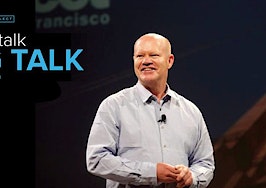When Apple announced the iPad in 2010, I was a sophomore in college lugging a monstrous green Dell laptop and an LG slider phone.
I couldn’t possibly imagine finding use for this frivolous slab of screen, what with my cutting-edge term paper generator and mobile QWERTY keyboard.
Five years later I found myself at the Apple Store, talking to a Genius about an iPad mini. It records interviews and plays music from room to room. The books and TV shows I carry around the airport got a lot lighter.
The players in the world of buying and selling homes have come a long way in embracing new tech amid delays and flubbed opportunities.
In 1989 principal brokers were barely using the computer. Today, flying cameras and goggles to the virtual universe are no longer fiction fodder but weaving into businesses.
As we look back on 2016, some trends stand out as profoundly influential on both real estate professionals and consumers. This year-in-review touches on those that moved the needle and show signs of a long shelf life.
1. Smart House (not the Disney Channel Original Movie)
My 33-year-old friend became a first-time homeowner this year. Excited, he showed me an image on his phone of a lit-up entryway. “That’s the view from my front door right now,” he said.
That’s made possible by his Kuna smart security light. He also has WeMo plugs for wireless lamp lighting control and a Weber smart thermometer for cooking, all of which is powered by the voice command-enabling Amazon Echo. This newbie buyer is smack dab in the millennial age range that’s predicted to be a hot buyer pool in 2017 and the coming years.
While “smart home” used to mean special wiring and a very pretty penny, the proliferation of relatively cheap, smartphone-controlled devices busted open the possibilities for convenience and practicality (including insurance discounts).
Research in 2016 from the National Association of Realtors (NAR) “Smart Homes and Realtors” indicates that although most consumers (82 percent) don’t ask their real estate agent about smart home devices, they’re still interested and paying attention.
Over half considered smart home security functions to be “very important,” while 42 percent of agents are interested in smart home certification.
According to the report, Realtors said the top three most important smart home tools for clients are:
- Smart locks, which may also give lockboxes a run for their money (37 percent)
- Lights (29 percent)
- Thermostats (26 percent)
Coldwell Banker VP of North American Public Relations David Siroty told Inman: “What we realized a couple years ago is that the home itself is changing, and for the first time. This is really the greatest time in home history when tech is impacting at such as rapid pace.”
Chris Heller, CEO of Keller Williams, added: “The number of homes with at least one smart home device has increased rapidly (to about 19 percent of all homes) because of the growing number of millennial homeowners and expanding brand awareness for companies like Nest.”
2. Don’t forget to pack your (VR) goggles
My first family Christmas gathering this year took place in Chicago. But we also went to Mars, the moon and the second deck of the Eiffel Tower thanks to the Samsung Gear VR headset.
And now VR infiltrates much more than fun and video games. In October, Matterport rolled out VR compatibility to all of its roughly 85,000 3-D active listing models, made possible by an automated conversion process. A privilege reserved for a handful of luxury agents suddenly became widely available.
Brokers set the new marketing standard with VR systems and headsets in their offices. Clients virtually tour 3-D models and 360-degree videos of listings and neighborhoods without leaving the couch.
When asked which marketing tools have been forces for change this year, Joel Burslem of 1000watt consulting said: “The first is the rise of 3-D tours and, as follow-on, the use of virtual reality to market homes … Anecdotally, I’ve heard a number of stories already about properties being sold sight-unseen to international buyers as a result of this technology, simply because the buyers were able to feel like they had stepped inside the home, even from thousands of miles away.”
Last month, a Coldwell Banker duo in Ohio turned a broker’s open into a virtual reality happy hour.
About 80 attendees (compared to the usual 20) perused the $1.65 million luxury property using Samsung headsets, smartphones and a Matterport camera, thrilling the seller — who never had to skedaddle with his dog in tow.
“With the introduction of VR headsets in 2016 such as the Oculus Rift, HTC Vive and Google Daydream View, the real estate industry is being flooded with innovators seeking to bring the VR experience to home buyers,” KW’s Heller said.
“The development of consumer-focused VR products is in its early stages, but because of its obvious potential, the real estate industry has been aggressively pushing 3-D model content creation.”
3. The crystal ball: from prototype to proliferate?
Real estate has a lot to gain from anticipating consumer movement and decisions, and tools for the clairvoyant-challenged wove their way deeper into the mainstream this year.
Both Coldwell Banker’s Siroty and ERA’s chief marketing officer Chris Trick spoke highly of the Zap platform, a CRM tool rolled out to all of the Realogy brands this year.
“While predictive analytics may not be brand new to the real estate industry, it has made great strides in 2016,” Trick said. “Personally, I’ve seen the strength of its influence in the Zap platform … Zap analyzes a complex array of homebuyer and seller activity and then assigns each customer a unique score. That score allows agents to provide the right message at the right time, creating personalized and streamlined service.
“It is important for all real estate professionals to embrace the power of predictive analytics through whichever tools are available to them — the future is here, and it’s time to adapt,” Trick noted.
Siroty added: “Zap [is] essentially telling the agent who is the right lead to spend your time and engage with, who should you start your drip marketing campaign to, who should you be reaching out to.”
Other well-known tools in this marketplace include:
- Offrs, which pinpoints likely sellers and markets to them for you (4,000 agents strong as of October)
- SmartZip, a predictive marketing company that raised $12 million in debt financing this year
- First, a contact-ranking tool that was a runner-up at Realogy’s 2016 startup contest — and more.
4. Somewhere over the rainbow — is a drone
Drones made headlines this year (more than a dozen at Inman, if you’re counting).
In March, NAR joined the rulemaking committee on drone technology.
“The aerial imagery made possible through UAS [unarmed aerial systems] technology will bring a new level of sophistication and accessibility to images and information, allowing the real estate professional to present a detailed portfolio to potential buyers,” NAR President Chris Polychron testified in front of a House subcommittee.
And in June, the Federal Aviation Administration (FAA) made it easier for agents to legally fly drones by removing the Section 333 waiver requirement for vehicles weighing less than 55 pounds.
Taking it one step further, in October drone mapping software company Pix4D dropped an app that lets users create aerial interactive 3-D models. (In other words, every tech nerd’s dream.)
5. Mad about video
However, not every property listing calls for the drone treatment. In fact, if you have a subdivision with no landmarks, the aerial view might actually hurt your marketing. (Those of you listing near the La Jolla cliffs, please drone on.)
You might even call 2016 the year of good-ole’ regular video — just look at your Facebook feed and tell Tasty to calm down.
Tech companies like VidBrander, which provides users with a library of short, professionally-produced consumer-focused real estate videos, and QwikVid (that turns around professional marketing assets within 24 hours after visiting the property) and more are making their play at agents.
Meanwhile, visionaries are diving into video fearlessly and with style and building YouTube followings. If clients say, “I feel like I know you already from your videos,” you’re doing something right.
6. Share your ‘Story’
If imitation is the sincerest form of flattery, then Snapchat must be truly honored this year.
In August, Instagram unleashed Instagram Stories for photo and video montages that disappear after 24 hours.
The copycat game appears to be going over just fine with Instagam’s 500 million users, and the decision reflects the 24/7 demand for fresh, raw content across today’s social media giants.
Most of my friends still hang over in Snapchat Story land, but the bloggers, businesses, satirists and media outlets I follow have hopped on Instagram Stories with full force.
Wherein lies the opportunity? In the words of Cave Social founder Jordan Scheltgen: “Spamming listings on Instagram is annoying; posting them to your story is informing.”
7. The tip of the iceberg for homeselling automation
Brad Inman’s crystal ball says 2017 will be the year of the homeseller.
“This coming year, technologists and venture capitalists will zoom in on homesellers, with the $60 billion pie up for grabs,” he wrote as one of his 11 predictions for 2017.
A $210 million funding round for Opendoor and the development of “transparent bidding” software by Haus, Faira and Reali this year appear to lay the groundwork for this to come true.
Co-founder and adviser for MetaProp NYC real estate tech accelerator Zach Aarons told Inman: “Probably the most disruptive force for consumers in 2016 was Opendoor, which has taken off like wildfire in certain markets.
“Another large force of disruption is happening in the leasing market with companies like Flip and Joinery. They are providing consumers with an option to assign or sublet a lease in a much faster and easier way than before, providing consumers more flexibility in residential living,” Aarons said.
Heller added: “There are a lot of entrepreneurs focused on bringing transparency to the real estate transaction — from allowing sellers to secure automated offers, to offering price guarantees to buyers, to allowing consumers to transact seamlessly on a single platform.
“Now some of these models are more ‘agent-friendly’ than others … but with the recent fundraising success that startups are enjoying, we expect more players to enter this space.”
8. Bots rising through Facebook Messenger and text message
Bots drummed up buzz this year, while text messages and Facebook Messenger emerged as deployment choices for bot creators. In August, developer Clark Giguiere developed a content delivery Messenger bot for Inman.
Popular CRM Contactually rolled out a bot for Slack and Facebook Messenger. Company CEO and founder Zvi Band described the purpose of automation in real estate as being about meeting consumers where they are, all the time.
Inman editor Amber Taufen predicted that Facebook Messenger could become the next frontier of customer service. She ordered a pair of shoes and was pleasantly surprised to stay apprised of their arrival so easily: A bot sent her updates via Messenger.
While bots remain on the periphery this year, their saturation may increase rapidly. Founder of Automabots Grant Gould told Inman that bots have been “mostly a conversation topic in 2016.”
“Yes, bots are more a part of our everyday life than most people realize and they make doing tasks more efficient, like getting instant answers to questions without all the manual steps it took just a few years ago,” he said. “We haven’t seen much in the way of direct impact on a Realtor business yet.
He added: “Although there are only a handful of AI labeled products, by Inman’s San Francisco Connect, we will see a dozen or so new services on the scene.”
Some already on the scene include Ask Doss, Holmes and Trulia’s rental bot.
In April, Inman conducted an experiment that pitted broker against bot in selecting homes for a buyer: The algorithm emerged victorious.
Moreover, bot transparency is one area to keep an eye on. As managing broker Sam DeBord poised in a thought-provoking column about bots who pretend to be human: If a consumer knew they were communicating with a machine, would they care?
“Probably not, if the outcome they desired had been delivered,” he wrote.
9. Franchisor, brokerage and agent websites stepping up their game — 3-D gets its heyday
In October, franchisor Sotheby’s International Realty began hosting immersive 3-D home tours on its listings pages, beating Zillow and realtor.com to the punch.
At one point, Zillow listings could link to a separate web page hosting a Matterport model, but the feature was later removed.
Sotheby’s 3-D integration also eliminated the step of traveling to a separate site to tour a model and signified a rare move by the real estate old-guard in pioneering innovation, Inman’s Teke Wiggin reported.
And according to a chat with Inman’s tech reviewer Craig C. Rowe, we’ve also seen agent websites hit saturation. “Instant, [basically] ‘hands-off’ websites are becoming the norm, almost,” Rowe said. “Crazy how easy it is now to get a ‘decent’ web presence.”
Individual listings can even have their own URLs with little hassle. KoaWare, praised by Rowe, builds high-quality single-property websites in under a minute, for example.
10. Sharing is caring (and lucrative)
In 2016, Uber and Airbnb have company in the sharing economy, where marketplaces are increasingly democratized.
Leaders at venture fund and tech accelerator program Moderne Ventures — Constance Freedman, Kurt Ramirez and Jeff Corbett — explained the collective impact of businesses that make collaborative consumption possible — and why they are “changing how real estate is sold.”
“An agent may be able to sell a larger home if the person knows they can rent out space on Airbnb,” they said in a statement. “[The] client may not need a two-car garage if ZipCar and a Bike Share option are across the street.
“Clients may be willing to go to a single family home over a condo if they know that TaskEasy will mow their lawn and Zaarly can take care of all their home maintenance needs.
“And that old fashioned split-level ranch that has been sitting on the market can be re-imagined by low-cost architects globally using ArcBazaar to turn that into someone’s dream home or an investor’s fix-n-flip. These are all examples of technologies that can change trends in homebuying.”
2016’s legacy
I wasn’t the only one who gave the side-eye to the iPad’s initial launch.
Among other skeptics, Jeremy Wyld, an Apple engineer who worked on the software for the device said: “I remember when I first saw it, I thought it was a rock fetch … to tell the truth. I thought, ‘This thing is ridiculous.’”
But because it disrupted the way people consumed books, newspapers, magazines, movies and television all at once, its change magnitude was even greater than the iPod and iPhone.
Consumers see past the marketing glitter, and once it shakes off, the functionality sticks — the problems it solves. The way it makes life easier.
What will make your business stronger?
Identify your inefficiencies, cumbersome processes and points of friction — let them guide your tech decisions next year. Then check your blind spot.















